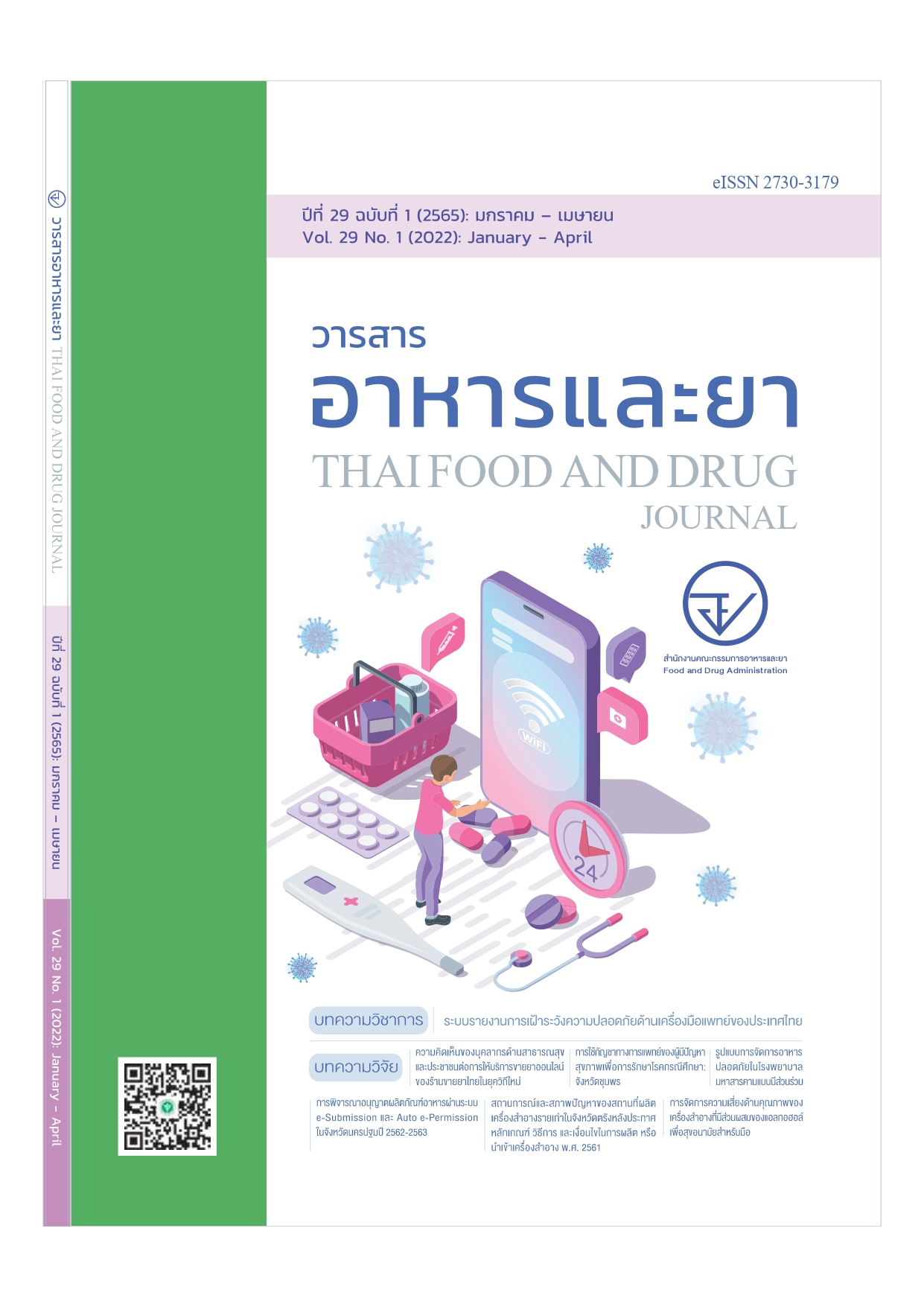สถานการณ์และสภาพปัญหาของสถานที่ผลิตเครื่องสำอางรายเก่าในจังหวัดตรังหลังประกาศ หลักเกณฑ์ วิธีการ และเงื่อนไขในการผลิต หรือนำเข้าเครื่องสำอาง พ.ศ. 2561
Main Article Content
บทคัดย่อ
ความสำคัญ: ประกาศกระทรวงสาธารณสุขเรื่อง หลักเกณฑ์ วิธีการ และเงื่อนไขในการผลิต หรือนำเข้าเครื่องสำอาง พ.ศ. 2561 มีผลบังคับใช้ตั้งแต่วันที่ 24 พฤษภาคม 2561 ทำให้ส่งผลกระทบต่อผู้ผลิตเครื่องสำอางที่ได้รับการจดแจ้งก่อนวันที่ประกาศนี้ใช้บังคับ ต้องปฏิบัติตามประกาศภายในสองปีนับตั้งแต่วันที่ประกาศนี้ใช้บังคับ
วัตถุประสงค์: เพื่อศึกษาสถานการณ์ และปัญหาของสถานที่ผลิตเครื่องสำอางรายเก่าในจังหวัดตรัง
วิธีการวิจัย: เป็นการศึกษาเชิงพรรณนาภาคตัดขวาง ในช่วงเดือนกันยายน 2562-สิงหาคม 2563 ใช้ประชากรผู้ประกอบการผลิตเครื่องสำอางทั้งหมดในจังหวัดตรังที่ยื่นขอจดแจ้งในระบบ e-Submission ของสำนักงานคณะกรรมการอาหารและยา โดยจัดทำฐานข้อมูลสถานที่ผลิต ตรวจประเมินมาตรฐานสถานที่ผลิตพร้อมให้คำแนะนำในการปรับปรุง และประเมินซ้ำ อธิบายข้อมูลด้วยการแจกแจงความถี่และร้อยละ
ผลการศึกษา: มีผู้ประกอบการผลิตเครื่องสำอางในจังหวัดตรังทั้งหมดจำนวน 33 แห่ง (ข้อมูล 10 กันยายน 2562) จำแนกเป็นกลุ่มสถานที่ผลิตที่ผู้ประกอบการประสงค์จะดำเนินกิจการต่อ 12 แห่ง (ร้อยละ 36.37) ต่อมาขอยกเลิก 2 แห่ง คงเหลือ 10 แห่ง กลุ่มสถานที่ผลิตที่ขอยกเลิกกิจการ 14 แห่ง (ร้อยละ 42.42) และกลุ่มสถานที่ผลิตที่ไม่สามารถติดต่อได้ 7 แห่ง (ร้อยละ 21.21) เมื่อตรวจประเมินสถานที่ผลิตในกลุ่มที่จะดำเนินกิจการต่อ 10 แห่ง พบว่า หมวดข้อบังคับที่ 6 การดำเนินการผลิต เป็นหมวดที่สถานที่ผลิตเครื่องสำอางมีผลการประเมินไม่ผ่านสูงสุด เช่น ไม่พบการตรวจสอบวัตถุดิบก่อนและหลังนำไปใช้ในกระบวนการผลิต ไม่มีป้ายแสดงชื่อวัตถุดิบและวันหมดอายุ ไม่มีวิธีการกำหนดเลขที่หรืออักษรครั้งที่ผลิต และไม่มีขั้นตอนการปฏิบัติงานในกระบวนการบรรจุ และเมื่อจำแนกรายละเอียดของหัวข้อที่ตรวจสอบทั้งหมดตามประเภทของปัญหา พบว่า ส่วนใหญ่มีปัญหาในด้านการจัดเตรียมเอกสารที่ใช้ในกระบวนการผลิต ตลอดจนการบันทึกรายละเอียดต่าง ๆ ตามเกณฑ์ที่กำหนด เนื่องจากขาดความรู้และการตระหนักถึงการควบคุมคุณภาพ นอกจากนี้ ยังพบสาเหตุการขอยกเลิกกิจการที่พบว่า เกิดจาก (1) มีการว่าจ้างผู้ผลิตรายอื่นเพื่อทำการผลิตและจดแจ้งเครื่องสำอางแทน (2) มีการแอบอ้างข้อมูลที่อยู่โดยบุคคลอื่นเพื่อยื่นขอเลขที่ใบรับจดแจ้ง (3) ปัจจุบันไม่ผลิตแต่ไม่ยื่นขอยกเลิกกิจการ และ (4) ข้อจำกัดงบประมาณ
สรุป: ผู้ผลิต 1 ใน 3 สามารถดำเนินกิจการต่อ โดยที่ช่วงระหว่างการตรวจประเมินพบปัญหาในหมวดการดำเนินการผลิตมากที่สุด ดังนั้น ผู้วิจัยจึงมีข้อเสนอเพื่อส่งเสริมการผลิตเครื่องสำอาง ดังนี้ (1) ภาครัฐควรออกนโยบายกระตุ้นเศรษฐกิจและส่งเสริมให้ผู้ผลิตมีรายได้เพิ่มขึ้น (2) จัดอบรมภาคปฏิบัติในด้านการควบคุมคุณภาพ การจัดเตรียมเอกสารและบันทึกในกระบวนการผลิต และศึกษาดูงาน ณ สถานที่ผลิตในจังหวัดอื่นที่มีมาตรฐาน (3) พัฒนาระบบการให้คำปรึกษาสำหรับผู้ประกอบการรายใหม่ผ่านช่องทางการติดต่อสื่อสารต่าง ๆ
Article Details

อนุญาตภายใต้เงื่อนไข Creative Commons Attribution 4.0 International License.
เอกสารอ้างอิง
1.ปุณณวีย์ หวังศุภกิจโกศล, ปริณดา เตชะศิรินุกูล, พิชญานิน อรรธนิศาสุข. คู่มือจดแจ้งเครื่องสำอางระบบอัตโนมัติ. นนทบุรี: อักษรกราฟฟิคแอนด์ดีไซน์; 2559.
2.กองส่งเสริมงานคุ้มครองผู้บริโภคด้านผลิตภัณฑ์สุขภาพในส่วนภูมิภาคและท้องถิ่น. สรุปผลการดำเนินงานคุ้มครองผู้บริโภคด้านผลิตภัณฑ์สุขภาพในส่วนภูมิภาค ประจำปีงบประมาณ พ.ศ. 2558 [อินเทอร์เน็ต]. นนทบุรี: สำนักงานคณะกรรมการอาหารและยา; 2558 [เข้าถึงเมื่อ 13 เม.ย 2562]. เข้าถึงได้จากhttp://www.fda.moph.go.th/sites/kbs/Shared%20Documents/Report_KBS/Report3.pdf
3.กองส่งเสริมงานคุ้มครองผู้บริโภคด้านผลิตภัณฑ์สุขภาพในส่วนภูมิภาคและท้องถิ่น. สรุปผลการดำเนินงานคุ้มครองผู้บริโภคด้านผลิตภัณฑ์สุขภาพในส่วนภูมิภาค ประจำปีงบประมาณ พ.ศ. 2559 [อินเทอร์เน็ต].นนทบุรี: สำนักงานคณะกรรมการอาหารและยา. 2559 [เข้าถึงเมื่อ 13 เม.ย. 2562]. เข้าถึงได้จาก http://www.fda.moph.go.th/sites/kbs/Shared%20Documents/Report_KBS/Report4. pdf
4.กองส่งเสริมงานคุ้มครองผู้บริโภคด้านผลิตภัณฑ์สุขภาพในส่วนภูมิภาคและท้องถิ่น. สรุปผลการดำเนินงาน
คุ้มครองผู้บริโภคด้านผลิตภัณฑ์สุขภาพในส่วนภูมิภาค ประจำปีงบประมาณ พ.ศ. 2560 [อินเทอร์เน็ต]. นนทบุรี: สำนักงานคณะกรรมการอาหารและยา; 2560 [เข้าถึงเมื่อ 13 เม.ย 2562]. เข้าถึงได้จาก http://www.fda.moph.go.th/sites/kbs/Shared%20Documents/KBS_Report_2560_Web.pdf
5.อภิษฐา ทรัพย์ประเสริฐ, จันทรรัตน์ สิทธิวรนันท์. การประเมินความคลาดเคลื่อนภายหลังออกสู่ตลาดของผลิตภัณฑ์เครื่องสำอางที่ได้รับการจดแจ้งโดยระบบการจดแจ้งอัตโนมัติ. วารสารอาหารและยา 2562;26(1):23-35.
6.สำนักงานคณะกรรมการอาหารและยา. ประกาศกระทรวงสาธารณสุข เรื่อง หลักเกณฑ์ วิธีการ และเงื่อนไขในการผลิต หรือนำเข้าเครื่องสำอาง พ.ศ. 2561. ราชกิจจานุเบกษา เล่มที่ 135 ตอนพิเศษ 117 ง (ลงวันที่ 23 พฤษภาคม 2561).
7.กลุ่มควบคุมเครื่องสำอาง สำนักควบคุมเครื่องสำอางและวัตถุอันตราย. แบบตรวจประเมินสถานที่ผลิตเครื่องสำอาง ตามประกาศกระทรวงสาธารณสุขเรื่อง หลักเกณฑ์ วิธีการ และเงื่อนไขในการผลิต หรือนำเข้าเครื่องสำอาง พ.ศ. 2561 [อินเทอร์เน็ต]. [เข้าถึงเมื่อ 13 เม.ย. 2562]. เข้าถึงได้จาก: https://www.ylo.moph.go.th/webssjold/file2018/kbs180661-2.pdf
8.กลุ่มควบคุมเครื่องสำอาง สำนักควบคุมเครื่องสำอางและวัตถุอันตราย. คู่มือสำหรับพนักงานเจ้าหน้าที่ (เล่ม 2) เรื่องแนวทางการตรวจสอบสถานที่ตามประกาศกระทรวงสาธารณสุขเรื่อง หลักเกณฑ์ วิธีการ และเงื่อนไขในการผลิต หรือนำเข้าเครื่องสำอาง พ.ศ. 2561. การประชุมเชิงปฏิบัติการตามโครงการส่งเสริมพัฒนาสถานประกอบการสู่มาตรฐานตามประกาศกระทรวงสาธารณสุขว่าด้วยการผลิตหรือนำเข้าเครื่องสำอาง ประจำปี 2563; 17 ธันวาคม 2562; โรงแรมมิราเคิล แกรนด์ คอนเวนชั่น. นนทบุรี; 2562. หน้า 150-158.
9.สมศรี ปรีชาทวีกิจ. การประเมินสถานที่ผลิตเครื่องสำอางตามหลักเกณฑ์ วิธีการ และเงื่อนไขในการผลิตเครื่องสำอาง. วารสารอาหารและยา 2562;26(3):68-78.


